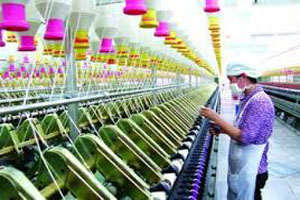
Chinese textile industry struggles over slow moving global market conditions
YarnsandFibers News Bureau 2015-02-18 14:00:00 – ChinaSlow moving global market conditions have hit China's labor-intensive industries, especially garment and textile production. As the textile industry struggles, cotton imports declined 44.9 percent year-on-year to 161,200 metric tons in January. This draws attentions to the challenges that domestic textile manufacturers face in a weak world market, according He Jingtong, a professor of international trade at Nankai University in Tianjin.
According to the General Administration of Customs, the nation's fast-fading advantage in some of the sectors it once dominated are exports of garment and yarn products declined 12.4 and 7.6 percent to 96.86 billion yuan ($15.5 billion) and 59.47 billion yuan, respectively. Shoe exports dropped by 10.8 percent to 34.88 billion yuan,.
Even though the US economy stabilized, it could not compensate for the lethargic demand from the European Union, Japan and many emerging economies, said He.
Orders for garment and yarn products from developed markets have been dwindling since mid-2011. Though many Chinese manufacturers are now less dependent on developed markets, exports are still the mainstay of their businesses, which are dominated by original equipment manufacturing.
Ding Lixin, a researcher at the Chinese Academy of Agricultural Sciences in Beijing, said that another factor behind falling cotton imports was the country's huge inventories.
Fast-growing domestic cotton output and the policy of paying a floor price for certain agricultural products have forced the government to spend more on storing domestic cotton, Ding said.
To reduce that burden, the government has pushed domestic textile enterprises to use more homegrown cotton in recent years. Cotton reserves rose to 11 million tons last year, half of the global total.
China pledged in September that the nation will not increase its cotton import quota this year beyond 894,000 tons.
Unlike China, prices of farm products in the United States, the EU and Japan are more market-driven, partly because of supply-demand relationships and the function of commodity markets such as the Chicago Board of Trade and Tokyo Commodity Exchange Inc.
According to Ding, China still relies on stockpiling and floor purchase prices that are supported by government subsidies to regulate prices. But the nation's minimum cotton purchase prices have remained above world levels in recent years, which prompted more imports from the US, India and Brazil in 2014.
As per the data from the Zhengzhou Commodity Exchange, the domestic cotton price is about 13,955 yuan a ton, while the landed price for cotton of a similar quality from India is 11,460 yuan.
It is this price different that prones Chinese garment or yarn factories to buy cheaper foreign cotton to make up for the rising costs of labor, energy and logistics.
According to Zhao Ying, a researcher at the institute of industrial economics of the Chinese Academy of Social Sciences, the chief government think tank, growing uncertainties in the world market will spur Chinese garment and yarn producers to move up the value chain.
Moreover, to expand their market the Chinese garment and yarn paroducers will have to offer high-end products and devise new strategies while the small, obsolete factories will be weeded out through competition over the next five years.
Market Intelligence
Ask for free sample Report

experience
Customer Base
dedicated team
Countries Served Worldwide









